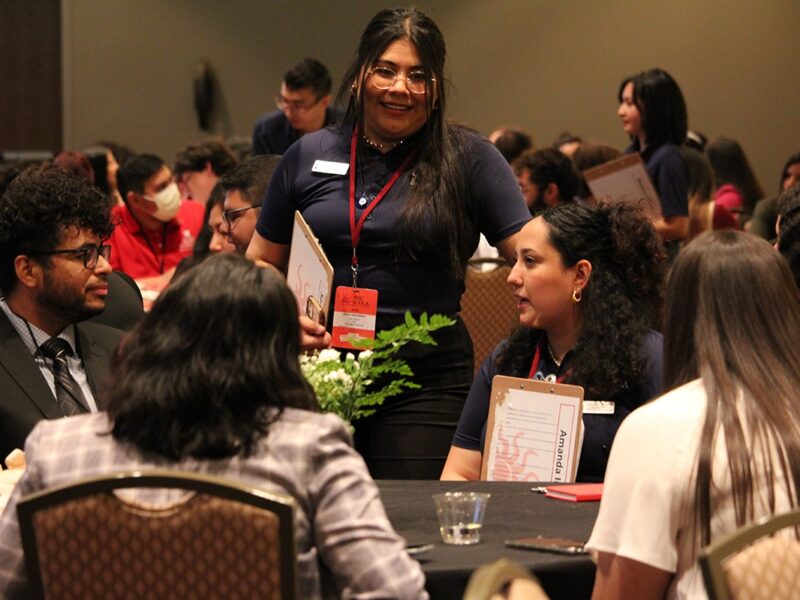Texas A&M To Commemorate 50th Anniversary Of Admission Of Women, Minority Inclusiveness
What a difference a half century has made at Texas A&M University, the first public institution of higher learning to be founded in Texas — founded as a land-grant college with a mandate for an all-male, all-military segregated student body.
It was indeed 50 years ago that the then Agricultural and Mechanical College of Texas gained university status and a new name, formally opened its student body to women—although officially then on a “limited basis” and enrolled its first African-American students. The stage was also being set to make participation in the Corps of Cadets optional. Gen. Earl Rudder, who served as president of Texas A&M from 1959 until his death in 1970, is credited with providing key leadership in initiating all of those transformational endeavors.
Texas A&M has emerged as one of the largest universities in the nation—with an enrollment of more than 50,000, with almost half of its students now women—and is making significant progress in diversifying its student body. The university’s leaders, however, agree that diversity in the student body, as well as among faculty and staff, is still less than desirable, particularly among African-Americans and Hispanics.
The university is gearing up for a semester-long, 50th anniversary commemoration with a series of “hallmark” programs focusing on women being formally admitted to the institution and enrollment of the first African-American students. The observance, which kicks off Sept. 10, is themed “Reflecting, Engaging and Envisioning: Celebrating 50 Years of Inclusion at Texas A&M University.”
All three hallmark events are free and open to the public. The kickoff event, on Sept. 10 at 9:30 a.m. in Rudder Auditorium, will feature an address titled “The Sky Is Not the Limit” by the first African-American woman astronaut, Dr. Mae Jemison, who also has credentials as a physician, scientist and entrepreneur. “Pioneers,” those who trail-blazed in various areas at Texas A&M — will be the focus for the second hallmark event on Oct. 16. The hallmark events will conclude with “Day of Engagement” on Nov. 12 and 13. Further details will be announced later in the fall.
In conjunction with the overall university commemoration, several of The Association of Former Students’ constituent networks will conduct related celebratory programs. They include the Black Former Student Network, Texas A&M Hispanic Network and Women Former Students’ Network
Texas A&M President R. Bowen Loftin and Student Body President Reid Joseph joined in issuing statements in support of the university-wide commemoration.
“As we celebrate this milestone anniversary, we take pride in the university’s development into one of the largest and most prestigious in the nation,” Loftin said in inviting the entire campus community, as well as the public, to participate in the planned series of events.
Joseph also cited the university’s progress over the past half-century, saying: “With the inclusion of women and African-Americans in the early 1960s, our university has continued to grow and flourish.”
It was 50 years ago this month—Aug. 23, to be precise—that, in name, the Agricultural and Mechanical College of Texas ceased to exist. That’s when Texas A&M — as it was informally known for decades before and since — formally became Texas A&M University. It took action by the 58th Texas Legislature to make it official for the institution that had been authorized under the federal Morrill Act of 1862. Texas A&M was founded on April 17, 1871, and officially opened on Oct. 4, 1876.
Action by the Texas A&M Board of Directors (now Board of Regents) on April 27, 1963, opened the doors for women to enroll at the formerly all-male, predominately military institution on a “limited basis.” The intent was for women to be allowed to enroll at Texas A&M if their desired fields of study were not available anywhere else in the state. However, women soon started enrolling in ever-increasing numbers, and no institutional attempt was made to limit the areas in which they could study.
Texas A&M then had 8,142 students. It enrolled more than 50,000 last fall and even more are expected for the start of the 2013 fall semester, with almost half of them women.
Months in advance of the passage of the landmark Civil Rights Act of 1964, admission to Texas A&M was opened to African-American students. The university currently enrolls more than 1,700 African-American students, with the university reporting modest gains in recent years. Officials there underscore their commitment to continuing to make higher enrollment of all minorities an institutional priority. Hispanics, the other ethnic minority group affected by the civil rights legislation, had been attending Texas A&M for decades.
Considerable thought, and some controversy, went into the name-changing process in the early 1960s, as noted in “A Centennial History of Texas A&M University, 1876-1976,” a two-volume publication written by Henry C. Dethloff, a history professor at the university who was on the faculty during the institution’s period of rapid and massive change.
“While some had advocated, in conformity to practices of other land-grant colleges, that Texas A&M be designated a “state university,’ as, for example, naming the college “Texas State University,’ the Texas A&M University designation was an effort to retain, at least in spirit the old familiar name,” pointed out Dethloff.
Although now retired, Dethloff continues to take an active interest in the university and monitors its progress. “Since 1962, challenges and change have defined Texas A&M University as it became a catalyst and facilitator of change and progress in Texas, the U.S., and in the global community,” he noted.
University officials emphasize the ‘A’ and ‘M’ in the institution’s name are not initials for “agricultural” and “mechanical” “even though agriculture and mechanical (engineering) programs continue to be major academic and research factors at the university, just as are a host of other top-flight fields of study. In fact, they note the ‘A’ and ‘M’ are not initials at all. They are simply letters intended as historical links hearkening back to the proud institution’s origin. Likewise, the ampersand replaced the “and” in the original name because “&” came into widespread usage in daily written references long before the formal name change.
Media Contact: tamunews@tamu.edu.





